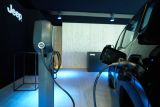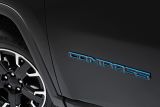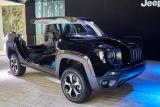A
Auto Express
Guest
Deliveries of both the Jeep Renegade 4xe and the larger Compass 4xe plug-in hybrids have been delayed due to the coronavirus. UK customers were originally set to take delivery from June, but due to the enforced closure of Fiat Chrysler Automobiles’ Italian factories, the new launch date is set to be closer to September.
According to reports in Automotive News Europe, FCA union workers have confirmed a phased re-opening of the group’s Melfi plant – where the Renegade, the Compass are built alongside the Fiat 500X – with roughly 500 of the full 7,400 workforce returning from 27 April. By the middle of the week, this number will increase to around 1,000.
The move will allow Jeep to produce the final prototypes of the plug-in SUVs, before full manufacturing can commence, which is expected around July.
Both 4xe versions of the Renegade and Compass are set to kick off with a pair of Launch Edition models. These will be offered in two specifications: a city-focussed “Urban” package or the rugged “Off-road” package. With the exception of their alloy wheel sizes (19-inches for the former and 17-inches for the latter), both options share the same level of standard equipment.
As standard, buyers get keyless entry and start, parking sensors, electrically operated door mirrors, a seven-inch digital instrument binnacle and an 8.4-inch touchscreen navigation system with smartphone connectivity and a reversing camera. The Renegade PHEV also comes with LED headlamps, while the Compass PHEV gets Bi-Xenon units.
Five exterior colours will be available on the First Edition models, with buyers offered Carbon Black, Alpine White, Granite Crystal Metallic, Blue Shade and Sting Grey. The launch edition SUVs will also come with a mode 3 charging cable, a five-year vehicle warranty and an eight-year battery warranty as standard.
Jeep Renegade and Compass 4xe: powertrain and chassis
Jeep’s pair of 4xe off-roaders will both be powered by the firm’s latest PHEV powertrain. The system comprises a turbocharged 1.3-litre four-cylinder petrol engine, a compact battery pack and an electric motor – offering a combined output of either 187bhp or 237bhp.
The latter system will be offered as standard in both launch edition SUVs, giving both cars a 0–62mph time of around seven seconds, CO2 emissions lower than 50g/km and a claimed all-electric range of 31 miles. Both will also be able to reach a maximum speed of 81mph on electric power alone. Jeep also claims that the Renegade and the Compass PHEVs can be charged in less than two hours using a conventional 7.4kW charger.
Both models will also feature Jeep’s new electric all-wheel-drive system. The front wheels are powered by the internal combustion engine, while the rears are driven by the electric motor – which alone generates 260Nm of torque, once fed through the rear axle’s 10:1 gear reduction system. Jeep says this system improves off-road performance, thanks to the amount of low-down grunt available from the electric motor.

Jeep Renegade PHEV hybrid

Jeep Compass PHEV hybrid

Jeep Compass PHEV hybrid

Jeep Renegade PHEV hybrid

Jeep Renegade PHEV hybrid

Jeep Renegade PHEV hybrid

Jeep Renegade PHEV hybrid

Jeep Renegade PHEV hybrid

Jeep Compass PHEV hybrid

Jeep Renegade PHEV hybrid
Jeep’s Head of Product Marketing, Marco Pigozzi, said: “The move from mechanical to e [electrified] all-wheel-drive is a massive improvement – it’s more capable than the conventionally powered Jeep. The enormous torque on offer from the electric motor allows [the car] to easily crawl over rocks and obstacles. And the fact that it’s mounted on the rear axle means [the car] is pushed up hills rather than pulled.”
Pigozzi was adamant that the shift from combustion-engined to plug-in hybrid drive would not compromise either SUV’s utilitarianism. To protect the drivetrain from rocks and exposed tree-roots when driving off-road, the Renegade PHEV is fitted with a range of steel underbody protection panels – all of which is made from recycled materials. Also, extensive waterproofing for the battery, engine, electric motor and EV controller, gives the range-topping Renegade Trailhawk a maximum wading depth of 500mm.
Like most plug-in hybrid vehicles, both new PHEV Jeeps are fitted with an energy recovery system, which features two levels of regeneration. Both also sport an “E-Save” function, which retains the state of charge in the battery for use later in the car’s journey.
FCA and Jeep’s future electrification strategy
These two new plug-in hybrid SUVs form the first part of Jeep’s electrification strategy. The Wrangler will be the next model in the company’s line-up to receive the PHEV treatment, with an electrified variant due to be previewed in early 2020 at the Consumer Electronics Show in Las Vegas. It will be revealed in full during the firm’s annual Camp Jeep event in July next year, before going on sale in September 2020.
Looking to the future, the Jeep Gladiator will go on sale in Europe in Autumn 2020. It will be followed by a new Grand Cherokee in 2021 and an “ultra compact utility vehicle” in early 2022, designed to rival the Suzuki Jimny.
We expect Jeep’s new 1.3-litre PHEV powertrain will also find a home under the bonnet of the new Alfa Romeo Tonale, which should share the same platform as the Renegade. Prices and full specs for the new powertrain are yet to be announced for vehicles across the FCA range, but we’ll update you when they’re available,
What are your thoughts on Jeep’s new PHEV models? Let us know in the comments section below…
Continue reading...
According to reports in Automotive News Europe, FCA union workers have confirmed a phased re-opening of the group’s Melfi plant – where the Renegade, the Compass are built alongside the Fiat 500X – with roughly 500 of the full 7,400 workforce returning from 27 April. By the middle of the week, this number will increase to around 1,000.
The move will allow Jeep to produce the final prototypes of the plug-in SUVs, before full manufacturing can commence, which is expected around July.
Both 4xe versions of the Renegade and Compass are set to kick off with a pair of Launch Edition models. These will be offered in two specifications: a city-focussed “Urban” package or the rugged “Off-road” package. With the exception of their alloy wheel sizes (19-inches for the former and 17-inches for the latter), both options share the same level of standard equipment.
As standard, buyers get keyless entry and start, parking sensors, electrically operated door mirrors, a seven-inch digital instrument binnacle and an 8.4-inch touchscreen navigation system with smartphone connectivity and a reversing camera. The Renegade PHEV also comes with LED headlamps, while the Compass PHEV gets Bi-Xenon units.
Five exterior colours will be available on the First Edition models, with buyers offered Carbon Black, Alpine White, Granite Crystal Metallic, Blue Shade and Sting Grey. The launch edition SUVs will also come with a mode 3 charging cable, a five-year vehicle warranty and an eight-year battery warranty as standard.
Jeep Renegade and Compass 4xe: powertrain and chassis
Jeep’s pair of 4xe off-roaders will both be powered by the firm’s latest PHEV powertrain. The system comprises a turbocharged 1.3-litre four-cylinder petrol engine, a compact battery pack and an electric motor – offering a combined output of either 187bhp or 237bhp.
The latter system will be offered as standard in both launch edition SUVs, giving both cars a 0–62mph time of around seven seconds, CO2 emissions lower than 50g/km and a claimed all-electric range of 31 miles. Both will also be able to reach a maximum speed of 81mph on electric power alone. Jeep also claims that the Renegade and the Compass PHEVs can be charged in less than two hours using a conventional 7.4kW charger.
Both models will also feature Jeep’s new electric all-wheel-drive system. The front wheels are powered by the internal combustion engine, while the rears are driven by the electric motor – which alone generates 260Nm of torque, once fed through the rear axle’s 10:1 gear reduction system. Jeep says this system improves off-road performance, thanks to the amount of low-down grunt available from the electric motor.

Jeep Renegade PHEV hybrid

Jeep Compass PHEV hybrid

Jeep Compass PHEV hybrid

Jeep Renegade PHEV hybrid

Jeep Renegade PHEV hybrid

Jeep Renegade PHEV hybrid

Jeep Renegade PHEV hybrid

Jeep Renegade PHEV hybrid

Jeep Compass PHEV hybrid

Jeep Renegade PHEV hybrid
Jeep’s Head of Product Marketing, Marco Pigozzi, said: “The move from mechanical to e [electrified] all-wheel-drive is a massive improvement – it’s more capable than the conventionally powered Jeep. The enormous torque on offer from the electric motor allows [the car] to easily crawl over rocks and obstacles. And the fact that it’s mounted on the rear axle means [the car] is pushed up hills rather than pulled.”
Pigozzi was adamant that the shift from combustion-engined to plug-in hybrid drive would not compromise either SUV’s utilitarianism. To protect the drivetrain from rocks and exposed tree-roots when driving off-road, the Renegade PHEV is fitted with a range of steel underbody protection panels – all of which is made from recycled materials. Also, extensive waterproofing for the battery, engine, electric motor and EV controller, gives the range-topping Renegade Trailhawk a maximum wading depth of 500mm.
Like most plug-in hybrid vehicles, both new PHEV Jeeps are fitted with an energy recovery system, which features two levels of regeneration. Both also sport an “E-Save” function, which retains the state of charge in the battery for use later in the car’s journey.
FCA and Jeep’s future electrification strategy
These two new plug-in hybrid SUVs form the first part of Jeep’s electrification strategy. The Wrangler will be the next model in the company’s line-up to receive the PHEV treatment, with an electrified variant due to be previewed in early 2020 at the Consumer Electronics Show in Las Vegas. It will be revealed in full during the firm’s annual Camp Jeep event in July next year, before going on sale in September 2020.
Looking to the future, the Jeep Gladiator will go on sale in Europe in Autumn 2020. It will be followed by a new Grand Cherokee in 2021 and an “ultra compact utility vehicle” in early 2022, designed to rival the Suzuki Jimny.
We expect Jeep’s new 1.3-litre PHEV powertrain will also find a home under the bonnet of the new Alfa Romeo Tonale, which should share the same platform as the Renegade. Prices and full specs for the new powertrain are yet to be announced for vehicles across the FCA range, but we’ll update you when they’re available,
What are your thoughts on Jeep’s new PHEV models? Let us know in the comments section below…
Continue reading...

